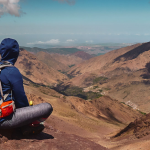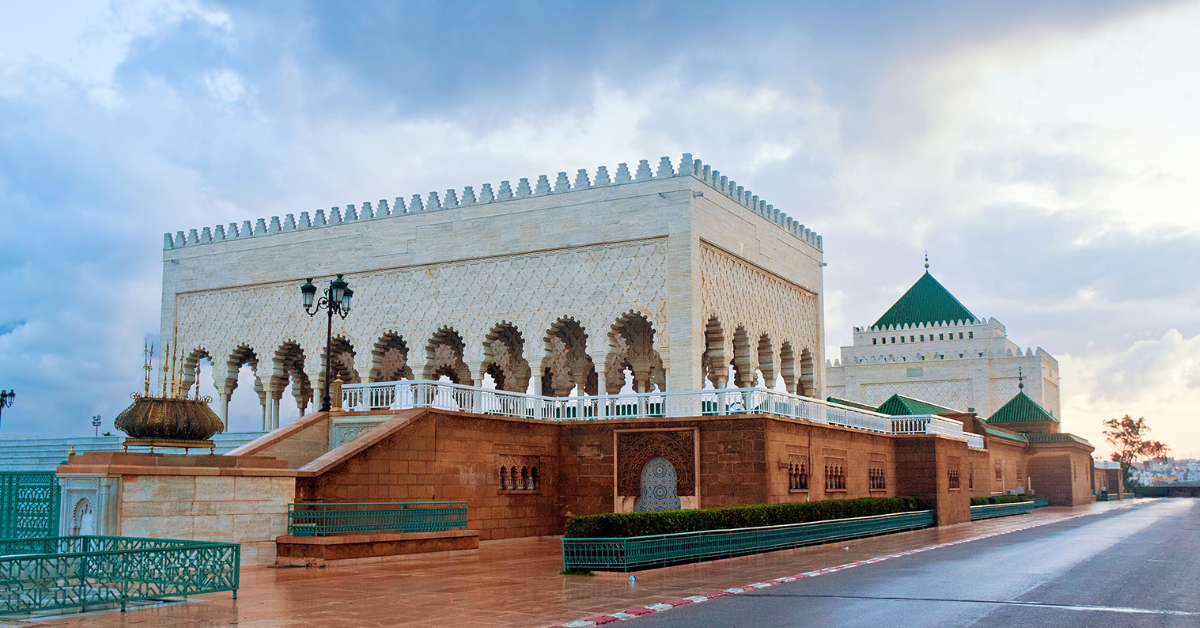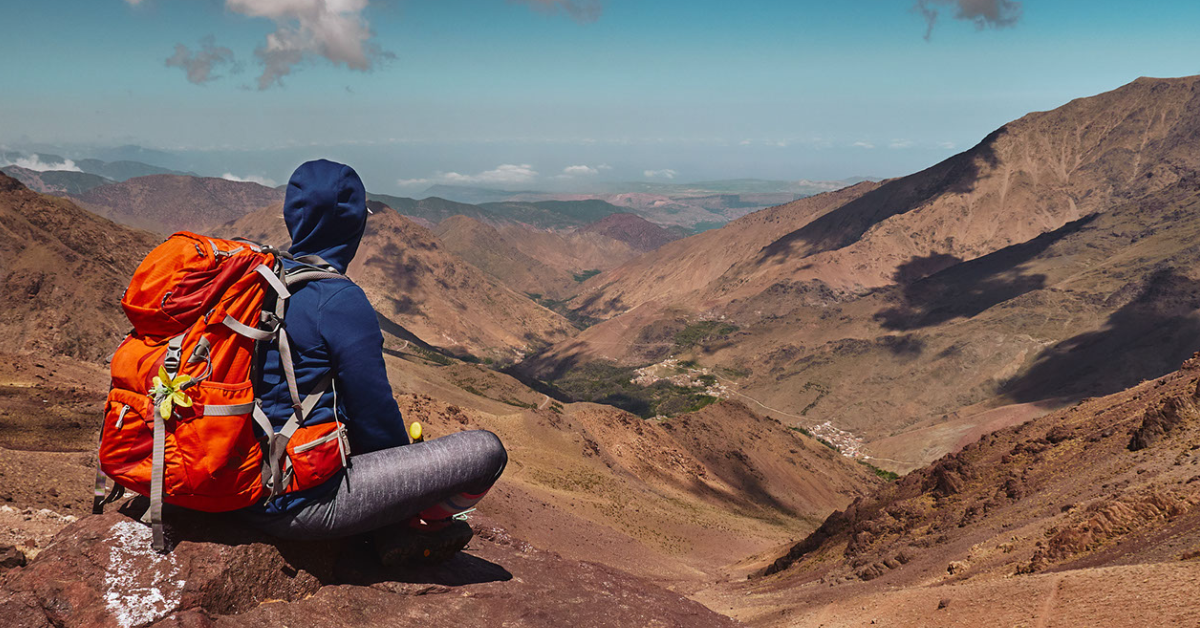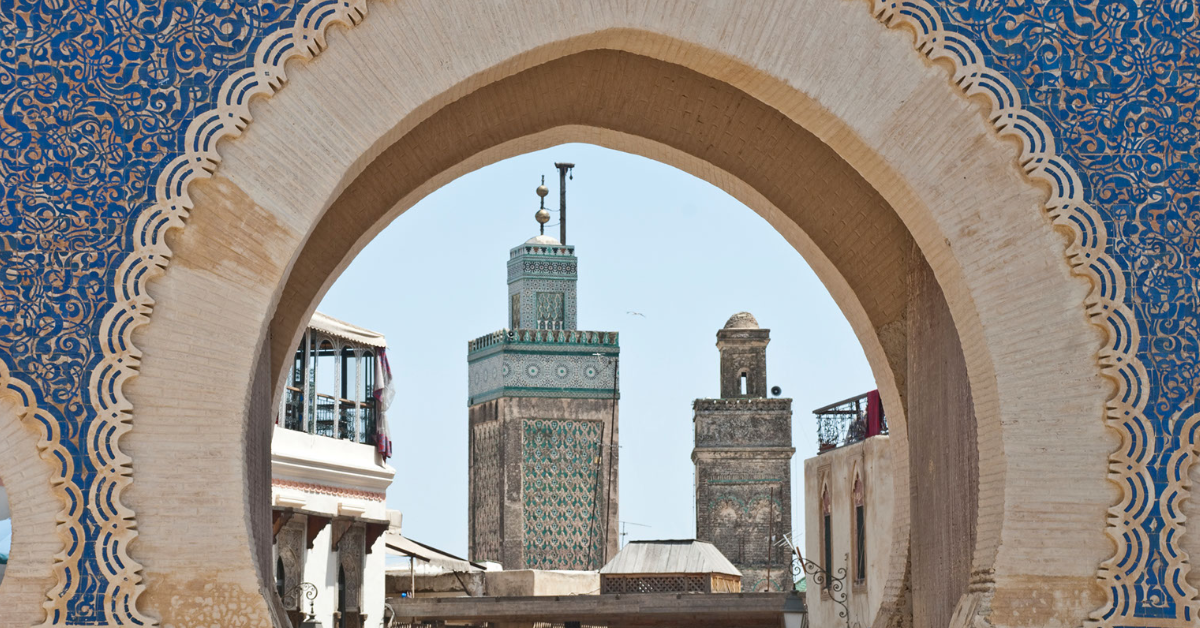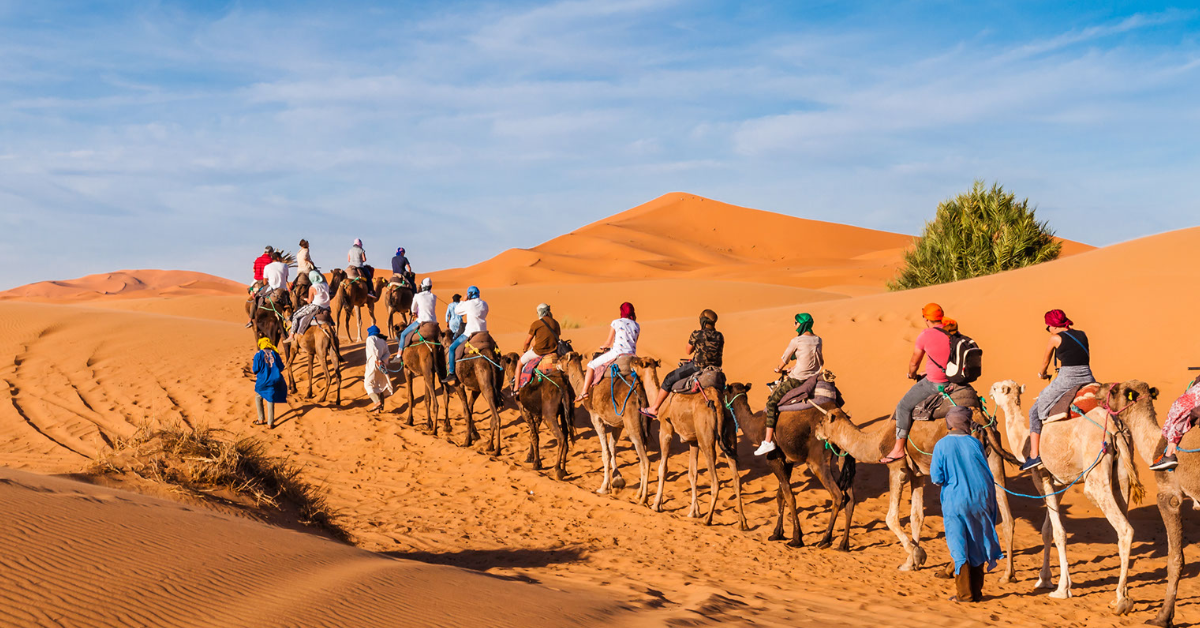Top 10 Tourist Attractions in Morocco
Top 10 Tourist Attractions in Morocco
With AFC Morocco Tours
Morocco is a country filled with natural beauty and cultural treasures, and one of its most impressive architectural wonders is the Telouet Kasbah, located in the heart of the High Atlas Mountains. The Kasbah is a testament to the rich history and cultural diversity of Morocco, and its strategic location on the famous Road of Caravans has made it an important stopping point for travelers throughout the ages.
These are just a few examples of Morocco’s diverse historical monuments, each representing a distinct era and culture. Exploring these awe-inspiring sites not only allows us to appreciate Morocco’s architectural and cultural heritage but also offers a deeper understanding of the civilizations that have shaped this enchanting country. Whether you’re wandering through the bustling medinas or standing in awe of ancient ruins, Morocco’s historical monuments are sure to leave an indelible impression on any traveler fortunate enough to visit. sense of connection to the past and a renewed appreciation for the enduring legacy of Morocco’s vibrant history.
As you travel through Morocco and immerse yourself in the stories told by these historical monuments, remember that they are more than just structures and ruins. They are testaments to the ingenuity, creativity, and cultural richness of the people who built them. They are reminders of the civilizations that have thrived and left their mark on this captivating land.
So, whether you find yourself marveling at the grandeur of the Koutoubia Mosque in Marrakech, wandering through the ancient streets of Fez Medina, or gazing upon the beautifully preserved mosaics of Volubilis, take a moment to reflect on the journeys that these monuments have witnessed and the tales they have to tell.
Morocco’s historical monuments stand as guardians of the past, inviting us to explore, learn, and appreciate the diverse tapestry of this magnificent country’s heritage. By preserving and cherishing these treasures, we ensure that future generations can continue to be captivated by the enduring spirit of Morocco’s historical legacy.
So, the next time you find yourself in Morocco, make it a point to visit these remarkable historical monuments. Allow yourself to be transported through time and experience the magic of a country where the past and present intertwine in a captivating dance.
1. Labyrinth Medina

From sampling traditional Moroccan street food at the nightly market to shopping for spices and artisan jewelry in the atmospheric souks, Medinas offers a stupendous opportunity for tourists and traders to explore a gamut of artifacts.
Well, to begin there are various Medinas in various cities of Morocco, each of them unique and alluring on its own. But here we speak specifically of the one located in the western Moroccan city of Marrakesh. The Medina is a densely packed, walled medieval city dating back to the Berber Empire (it’s pretty old for all you need to know), with maze-like alleys where thriving souks sell traditional textiles, pottery, and jewelry.
Firstly we enter from Djemma el-Fna Square, a plaza surrounded by a repertoire of vendors and performers promoting their culture, art, and skill, but mostly selling a bizarre mix of ornaments and antiquities. of Once you enter the medina itself, you find yourself around a kaleidoscope of colors, scents, and sounds which are bound to be the highlight of your trip.
2. The good ol’ Hassan 2 Mosque

From Marrakech, we come further west to the largest city in Morocco, Casablanca. Casablanca’s major point of interest and landmark building, the Hassan II Mosque is a lavish symbol, not only of the city but of Morocco itself. It is the largest mosque in Africa and the third largest in the world.
Exemplifying Morocco, this mosque is fashioned out of materials from around the country. Minutely detailed mosaics coupled with exceptional patchwork and woodwork carefully seeded in every corner of the colossal mosque without modern-day equipment are some of the finest examples of Islamic craftsmanship. It makes one wonder how something so minuscule finds a perfect place in this greater unfolding of things! The minaret is 60 stories high topped by a laser, that directs light towards Mecca. The mosque has glass floors allowing worshippers to pray directly over the ocean, thus creating a beautiful parallel between land and sea.
So if you are ever planning a trip to Morocco, making a stop in Casablanca to experience the absolute wonder and splendor of the Hassan 2 Mosque, should be high up on your list.
3. ‘Over the hill, Volubilis

History has proven time and again, that even the greatest of empires eventually crumble
Although there are several interesting citadels for History buffs, we will specifically target the one which is UNESCO described as “an exceptionally well-preserved example of a large Roman colonial town on the fringes of the Empire”. Volubilis is situated 33 km north of the city of Meknes(so it’ll take a full day to visit this), and is commonly considered as the ancient capital of the kingdom of Mauretania (again it’s pretty old). We ask only for a day to experience the magnificence of the fort.
The hilltop location allows the ruins to look over the surrounding countryside, adding to the romantic ambiance of lost glory. Head up through the ruins to the Capitol and Forum to feast on the views. It is one of the best preserved archaeological sites with mosaic floors standing tall and strong even today. A perfect place for a nomad, isn’t it?
4. Murish Kasbah of Udayas In Rabat
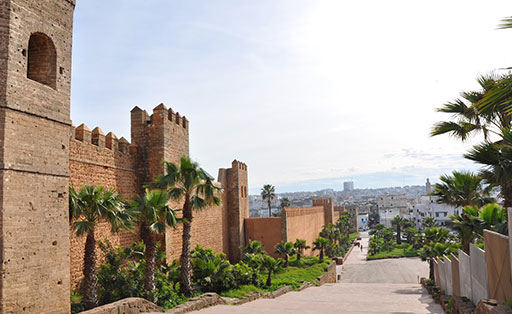
Finally, we come to the capital! Morocco has plenty of beautiful old town areas but Rabat’s Udayas Kasbah neighborhood has to be one of the country’s most picturesque places. It was originally built in 12th century and is listed as a UNESCO World Heritage site.
This is a peaceful and perfectly quaint district. Inside the walls of this old fortress, the lanes of neat white-and-blue houses rimmed by colorful flower pots have a ‘lost-in-time’ atmosphere that’s hard to beat. At the site of Kasbah, are famous Andalusian gardens, which remain a popular spot for locals and tourists alike. Walk up the steps leading to the imposing gate of Bob Oudaya and discover the winding streets of the Kasbah that will take you to Rabat’s oldest mosque and beautiful gardens. If you plan, you can be a part of an annual music festival, held at a site adjacent to Kasbah.
5. Blue City Chefchaouen

Hiking? Trekking? Swimming?
Set amidst the Rif mountains, Chefchaouen also known as the ‘blue city’ or ‘blue pearl’ is a small town in northwest Morocco. Historians have come up with various theories on why the city had been painted blue but most of them agree on the blue meant to represent peace, safety, and the power of heaven.
Exploring a labyrinth of narrow blue alleyways, the streets open into public squares. The mountains above the city give the appearance of two horns and it is believed that this is where the name Chefchaouen comes from (literally meaning ‘watch the horns’ in the local dialect). Go shopping, have a meal at the local café, or go hiking in the nearby hills.
6. Chilly Toubkal National Park
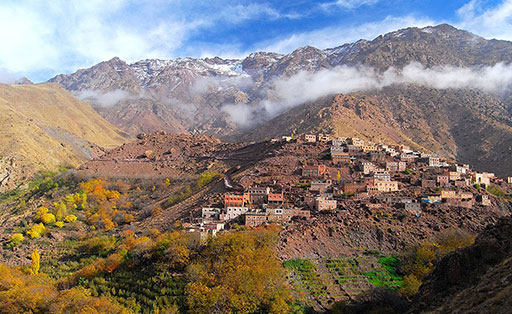
It is located in the High Atlas mountain range, 70 km from Marrakesh in central western Morocco. Established in 1942, it is home to the country’s highest mountain( Jebel Toubkal) in Africa. Picturesque backdrops of the beautiful city, await tourists embarking on a hiking adventure. The time to come is summer when all the trails are open. Also, the trekking journey provides valuable insight into an ancient civilization. The historical aspect is matched with the physical aspect of hiking up the highest mountain in North Africa. The park has a rich and diversified faunistic population, composed of mammals, birds, reptiles, and invertebrates. Longing for some wild adventure? This is just the place for you.
7. Gusty Erg Chebbi
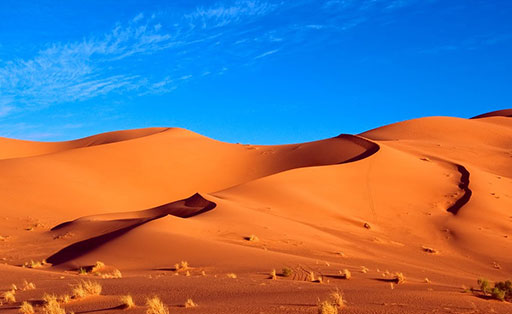
The erg takes it name from the Arabic word ‘arq’ meaning ‘dune field’. Located in Saharan Morocco, the dunes of Erg Chebbi rise up to 150 meters. A perfect place for explorers to get a dose of desert action. One can go for an armamentarium of activities ranging from camel trekking and desert hiking to dune surfing and four-wheel-drive and finally swimming in the heart of the Sahara desert.
Oh yes, you read it correctly! For the not-so-adventurous ones, just sitting amid the dune splendor is worthy enough of the long journey out here. For most travelers who make it this far, the climax is sleeping under the stars at a desert camp illuminated with lanterns, amid the dunes themselves (one can also choose a hotel nearby). Further, the surrounding Sahara Desert makes way for many such challenges and opportunities alike. So, pack your bags (don’t forget to take enough water, the ones there are pretty expensive) and get ready for a bumpy camel ride.
8. Ancient Koutoubia Mosque

The Koutoubia Mosque is the largest mosque in Marrakesh located in the middle of Medina opposite Jemaa el fna square. The mosque is made from hewn stone and embellished with curved windows, a band of ceramic inlay, and decorative arches, glorifying a rich cultural history. It has a magnificent plaza with gardens and is floodlit at night. The mosque’s 12th-century 70-meter-long minaret tower is considered an important landmark of Marrakesh.
In the 19th century, booksellers clustered around its base – hence the name kutubiyyin (booksellers). The minaret’s gleaming brass spire keeps it shining around the year. Non-Muslims are not allowed into the mosque itself, but we assure you that taking a few hours out of your day will be worth it!
9. Palatial Bahia Palace
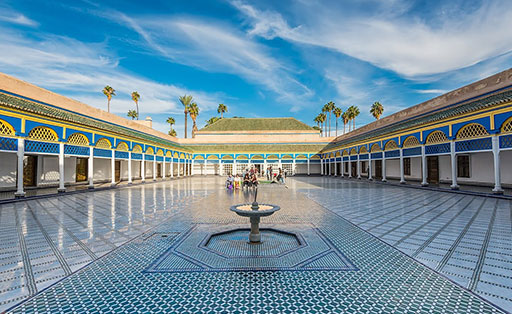
The Bahia Palace is a breathtaking traditional Morrocan structure containing a set of gardens and plazas located in Marrakesh, Morocco. The name itself means ‘brilliance’, evident from its mesmerizing structure.
This magnificent peacock of a palace was built in the late 19th century. The interior decoration is a dazzling display of mosaic tiles, painted ceilings, and ornate structures showcasing the opulent lives of those high up in the sultan’s favor at that time. The colossal marble courtyard and sumptuous salons are the two main attractions, while the lush internal courtyard of the grand riad, with its banana-leaf plants and citrus trees, is a tranquil respite from the city. Each room is decorated in truly elegant Moroccan style-using carved stucco and cedarwood.
Splendid courtyards, exquisite gardens, and a glorious past make it a must-see palace, open to the public every day of the week.
10. Botanic Majorelle Gardens
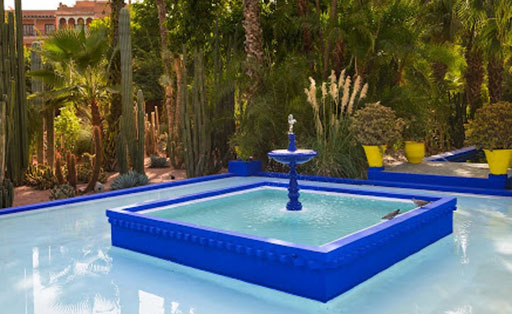
‘Blue and green should not be seen without another color in between. Well, it seems all roads lead to Marrakech!
The Majorelle Garden is a two-and-a-half-acre botanical garden in Marrakech. It was named after its creator, French Orientalist artist, Jacques Majorelle, who worked on it for almost forty years and it features a Cubist villa designed by the French architect Paul Sinoir. The villa houses the Islamic Art Museum of Marrakech, the Berber Museum, and the Yves Saint Laurent Museum.
A 12-acre oasis in the middle of the garden has given the world its own vibrant and distinctive color: Majorelle blue. Majorelle Garden is open daily, all year round. The site has been ranked as Morocco’s most visited tourist attraction.
A symbol of paradise, the gardens of Marrakech are perfect in the midst of the hustle and bustle of the city. A visit to this masterpiece is imperative on your trip to Morocco!
Well, the plethora of adventures Morocco offers cannot be completely narrowed into a comprehensive list of ten attractions. Visit Morocco before ‘Time goes by’?







